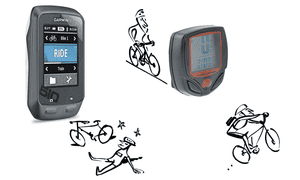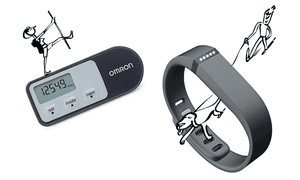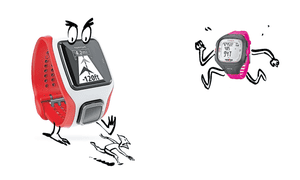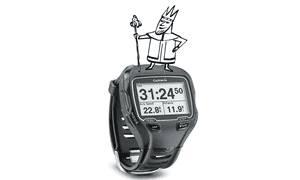Cycling
Bike computers can range from very basic up to all-singing all-dancing. At the bottom end, you can invest £9.99 and get yourself a Challenge 14, a reliable little device that will tell you your speed and distance using a sensor that you attach to the wheel.
Take a leap into the more expensive GPS devices, though, and you get a lot more potential.

The Garmin Edge 510 (£249.99) is a mid-range GPS bike computer that mounts on to your handlebars to give you constant access to speed, distance and elevation information with a touchscreen that works even when it’s raining or you’re wearing gloves. As soon as you’ve completed a session, it can wirelessly transfer the data to your smartphone. You can then analyse every section of your ride and measure your progress, and it can also upload to other popular cycling apps such as Strava and MapMyRide.
It’s not difficult to set up, as everything is measured using GPS, so there are no wires or wheel sensors. It will also wirelessly connect with compatible gadgets such as heart rate monitors and cadence (pedal strokes per minute) sensors, which you can buy separately.
Walking
The power of a pedometer should not be underestimated. We’re always told that we should take the stairs instead of the lift, or get off the bus two stops early, but once you’re wearing a pedometer you become positively hungry for opportunities to rack up your daily step count and you’ll see your fitness skyrocket. The simple and inexpensive Omron Walking Style One 2.1 (£22.95) monitors your steps, distance and calories burned, plus it has three-dimensional sensor technology that enables you to carry it in your pocket or bag. Its seven-day memory allows you to look back at how much you’ve done that week.

If you’ve got a bigger budget, try the Fitbit Flex Wireless Activity & Sleep Wristband (£79.99).The wristband also records steps, distance and calories, but it wirelessly connects to your chosen device (smartphone, tablet or computer) so you can see several weeks/months of progress and set goals. It vibrates gently when you reach a pre-set goal, and even tracks your sleep quality, waking you gently and silently in the morning by vibrating.
Running
The gadget you buy here depends on how seriously you take your running.
If you’d simply like to know how fast and how far you’re going, plus calories burned, then the Timex Ironman Easy Trainer (£99.99) is spot on. It uses GPS for excellent accuracy, stores up to 30 workouts, is easy to set up, slimline and comfortable.

However, for the true running geek, there’s the TomTom Runner Cardio watch (£219.99), launched this year. It’s pricey but does practically everything apart from doing the actual running for you. It has an advanced built-in heart rate monitor, which shines a light through your skin to monitor you.
It also has built-in GPS, which tracks your speed, distance and route, and all data can wirelessly transfer to your smartphone and then computer.
Swimming
It’s easy to become stuck in a rut with swimming, ploughing up and down at the same speed while trying to keep count of your laps. Investing in a swimming watch is a brilliant way to motivate yourself to become fitter and faster by providing you with a satisfying collection of stats, both while you’re swimming and afterwards. The Swimovate PoolMateLive (£90, plus £30 for download clip) counts your laps, and monitors speed, distance, calories and even stroke length and efficiency. It also helpfully vibrates when you reach your target distance or time.

If you buy the download clip, you can load the data on to your computer and see the statistics from each individual lap you’ve swum. The characters on the watch face are very big (easy to see through goggles) and it’s a doddle to set up.
All of the above
Finally, the king of watches for those who indulge in several sports and don’t want a different device for each – the Garmin Forerunner 910XT multi-sport watch £289)

Yes, it’s expensive, but this magical device can track you for swimming, cycling and running (so it’s ideal for triathletes). It will provide lots of useful numbers, such as laps, speed, distance and elevation using GPS and an altimeter, alongside a multitude of other techy wonders, such as tracking your path during open-water swimming, so you can see if you swam in a straight line, and a virtual racer feature that allows you to race against other people or your own previous personal bests. If you want additional stats, such as heart rate, it connects with compatible wireless sensors, such as heart rate monitors. It’s chunkier than single-sport watches, but that’s to be expected from a computer that packs in so many functions.
Source: Read Full Article
